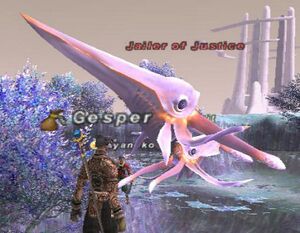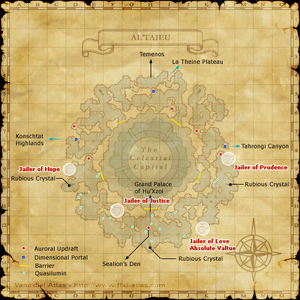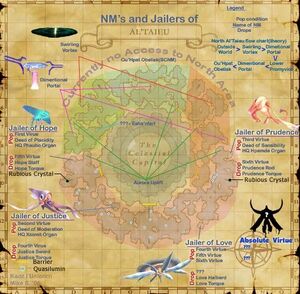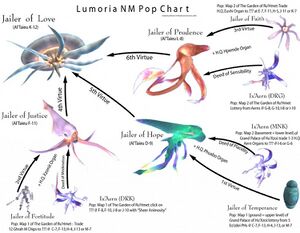Jailer of Justice
| Zone | Level | Drops | Steal | Spawns | Notes |
|---|---|---|---|---|---|
| Al'Taieu | 85 |
(100%)This template is no longer in use.Editor: Please replace{{Drop Rate|total drops|total kills}} with {{Hxi Drop Rate|asb=#/1000|total drops|total kills}} ASB rates can be found via Special:ASB Search and has accurate drop rate information for HorizonXI. If a drop rate is listed there as eg. 24% then set "asb=240/1000" etc.This template is commonly used on mob pages. If you are adding a new mob page, we kindly ask that you use the new HorizonXI template Template:Infobox Monster. Thank you! This template is no longer in use.Editor: Please replace{{Drop Rate|total drops|total kills}} with {{Hxi Drop Rate|asb=#/1000|total drops|total kills}} ASB rates can be found via Special:ASB Search and has accurate drop rate information for HorizonXI. If a drop rate is listed there as eg. 24% then set "asb=240/1000" etc.This template is commonly used on mob pages. If you are adding a new mob page, we kindly ask that you use the new HorizonXI template Template:Infobox Monster. Thank you! This template is no longer in use.Editor: Please replace{{Drop Rate|total drops|total kills}} with {{Hxi Drop Rate|asb=#/1000|total drops|total kills}} ASB rates can be found via Special:ASB Search and has accurate drop rate information for HorizonXI. If a drop rate is listed there as eg. 24% then set "asb=240/1000" etc.This template is commonly used on mob pages. If you are adding a new mob page, we kindly ask that you use the new HorizonXI template Template:Infobox Monster. Thank you! |
1 | L, T(S) ~37,000 HP | |
|
HP = Detects Low HP; M = Detects Magic; Sc = Follows by Scent; T(S) = True-sight; T(H) = True-hearing JA = Detects job abilities; WS = Detects weaponskills; Z(D) = Asleep in Daytime; Z(N) = Asleep at Nighttime; A(R) = Aggressive to Reive participants | |||||
Notes:
- Spawned by trading the Second Virtue, Deed of Moderation, and HQ Xzomit Organ to the ??? at (F-11).
- It can summon up to 6 Qn'xzomits.
- Like normal Xzomits, they move at Flee speed.
- The Jailer is immune to stun.
- They have 2,000~ HP and use Mijin Gakure not too long after being attacked. This is reminiscent of Bomb Queen's Self-Destructing helpers.
- The Jailer of Justice summons them one at a time, but summons often (about every 30 seconds).
- If engaged as soon as they pop, the helpers will Mijin Gakure immediately as the jailer completes the summoning of the next helper.
- Qn'xzomits will not engage a character who is outside the party/alliance with claim on Jailer of Justice unless that character engages them directly. This means that if someone is casting cure from outside of party/alliance, they will not be targeted by the Qn'xzomit pets.
- The Jailer can charm people for long periods of time--multiple minutes. It will usually charm the main tank. It CAN Charm when it has its 6 Qn'xzomit alive.
- Hate behaves unexpectedly, often switching target inexplicably when it completes summoning. Both Jailer and Helper will switch target seemingly at random but often to the character who popped the NM. Sometimes, the Jailer will behave as expected but the Helper will pick an unexpected target.
- The Jailer itself seems rather weak and not too special, but its helpers seem to give people the most trouble.
- Respawn on ??? is 5 minutes
 .
. - It has approximately. 30,000 HP.
- Best fought with a party of two melee (two thieves if the torque is desired) and a healer with Sleep outside of the party. The healer will only need to use sleep on a charmed character.
Dialogue
The "???" at F-11 says:
"Desssireth...thou?
Sssecond...irtue...
Deed...ressstraint...willpo...er...
...from...fallen...Xzom...
...cannot...derssstand...them"
The fragmented dialogue is referring to the Second Virtue, the Deed of Moderation (restraint, willpower), and a HQ Xzomit Organ (something from a fallen Xzomit).
Historical Background
The Heavenly Virtues
The 7 Jailers of Sea are based on the 7 Virtues. Virtue is defined as moral excellence. Virtue can accordingly be characterized as having desirable character traits, traits which direct a person to act in accord with the best possible standard. In other words, Virtues improve us towards the idealized perfection of our being. In order to be virtuous, one must continuously have virtues as habits of their character. The idea of Virtues originate with the ancient Greeks and the idea was later picked up and made a part of Christian moral theology, probably during the Medieval era. There are 2 sets of virtue: the cardinal virtues (sometimes called the classical virtues) & the theological virtues. The former originate with the ancient Greeks and the latter originates in the Bible (New Testament), specifically 1 Corinthians 13, but became popular in Medieval Christianity. The cardinal virtues are: Prudence/Wisdom, Justice, Fortitude/Courage, Temperance. The theological virtues are: Faith, Hope, Charity/Love. Together, these seven virtues were called the Heavenly Virtues or simply the Seven Virtues. The pairing of these seven virtues appeared to have originated with 13th century Christian philosopher Thomas Aquinas in his work "Summa Theologica". They became a popular element for depiction in the Medieval and Renaissance periods.
According to ancient Greek philosophy, they viewed each Virtue as being the mean on a spectrum of some characteristic. As such, each Virtue would have 2 vices associated with it, lying at the extremes of that spectrum. Note that the Virtue was the mean, not necessarily the median between both vices. According to Medieval Christian thought, these virtues are said to improve one's love of God and Man. The cardinal virtues are dispositions of one's being which govern one's actions, restrain their passions and guide their conduct in accordance with reason. The theological virtues are said to give Christians the ability to live in a relationship with the Holy Trinity. They are considered to give life to all the moral virtues (the cardinal and theological virtues). The Heavenly Virtues are generally limited to the Roman Catholic denomination of Christianity. It should be noted the Chinese, Muslim, and other cultures have different sets of virtues.
The seven Heavenly Virtues do not align up with the Seven Deadly Sins. The seven Holy Virtues (or Contrary Virtues) do though, which are: Humility (counters Pride), Kindness (counters Envy), Patience (counters Wrath), Abstinence (counters Gluttony), Chastity (counters Lust), Liberality (counters Greed), Diligence (counters Sloth).
The Virtue of Justice
Justice (Iustitia) is one of the Virtues. It is a cardinal virtue which originated with the ancient Greeks and was adopted by Christianity. Justice is the concept of fair, impartial, moral treatment of people. It is giving people what they are due within the proper constraints of society. The law, the legal system can said to be aspiring towards the concept of Justice (though it obviously fails to reach it quite often). Under ancient philosophy, it also meant a code of behavior which would be considered just, such as not lying, nor stealing.
Justice (Dikaiosyne/Dikaiosune) was considered the top virtue by the ancient Greeks. It was considered the harmony of the soul and that which would bring people and society the most happiness. Justice causes one to treat those around them with fairness and equity, giving praise, priviledge and reward to those with the merit or status deserving it. Justice was the mean between injustice, which lies beyond the mean of Justice in any direction. They considered Justice to arise only when Wisdom, Courage, and Temperance existed. It is created when the 3 parts of the soul (the rational part, the passionate part, and the desiring part) are in such harmony as it is one soul with no divisions. To Medieval and Renaissance-era Christians, Justice was the Virtue which held mankind to respect the rights of one another and to have equitable relationships with other people. Justice also caused people to aspire to the common good. They believed Justice was accompanied by the gift of piety and it could challenge the vices of injustice in all its forms.
In Medieval and Renaissance art, Justice is frequently depicted as a calm-expressioned woman holding a sword in addition to a balance scale (usually the sword in her right hand, the balance in her left hand). This sword was the sword of mercy, a longsword with a blunt tip. This explains why the Justice Sword drops and not some other type of weapon. The Virtue of Justice is occasionally, but not often, depicted blindfolded. She was usually depicted with eyes half-closed, looking at the scales of balance. The blindfolded figure of Justice stems from a representation of Justice in the ancient Greek legal system.
The Jailers of Sea
It is not clear what the proper context of the Jailers is. "Jailer of (Virtue)" can be taken two ways. First, it can imply they are the Jailer of (Virtue), imprisoning that Virtue (or more specifically, imprisoning one aspect of Absolute Virtue). This would mean they do not possess the Virtue, they jail it. Second, it can imply they are the Jailer of (Virtue), being a jailer possessing that virtue. This would mean they are a jailer which possesses the Virtue in question. In this case, they would not be jailing the Virtue in their name, they would be jailing the monster known as Absolute Virtue. The latter interpretation is more logical since each Jailer drops a weapon and a torque bearing their namesake Virtue. If they were to be jailing the Virtue in question, it would make more sense for them to drop weapons and torques not named after the virtue, like objects named after the 7 Vices or the 7 Sins. Since the title you gain for defeating Absolute Virtue is "Virtuous Saint," this is the more widely accepted context. However, the former also makes sense because if the jailer is defeated, the virtue it was imprisoning is released. Absolute Virtue, interestingly, appears to drop 7 items named after synonyms for the deadly sins. It may drop these sins because upon defeating Absolute Virtue you theoretically destroy all the virtues, leaving the only thing left to gain to be sins. It is also possible that the sins are the "chains" placed on Absolute Virtue.
* Sin of Indignation (wrath) * Sin of Insolence (pride) * Sin of Indulgence (greed) * Sin of Infatuation (lust) * Sin of Indolence (sloth) * Sin of Invidiousness (envy) * Sin of Intemperance (gluttony)




